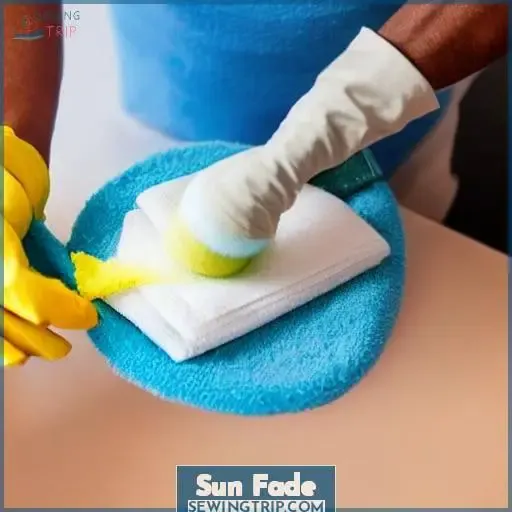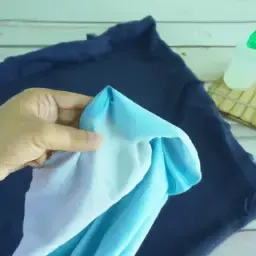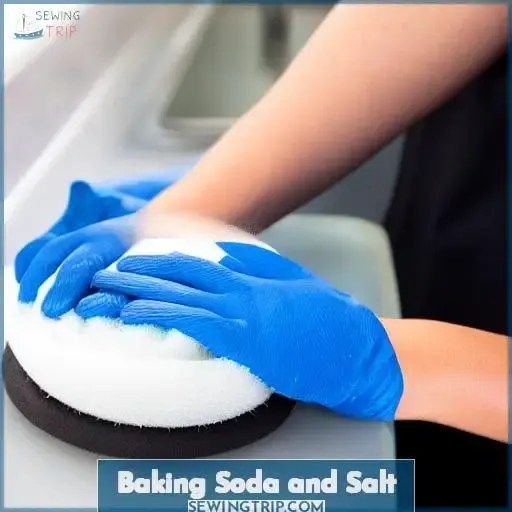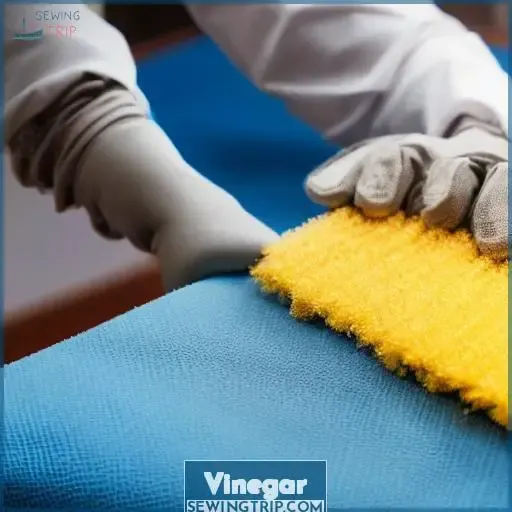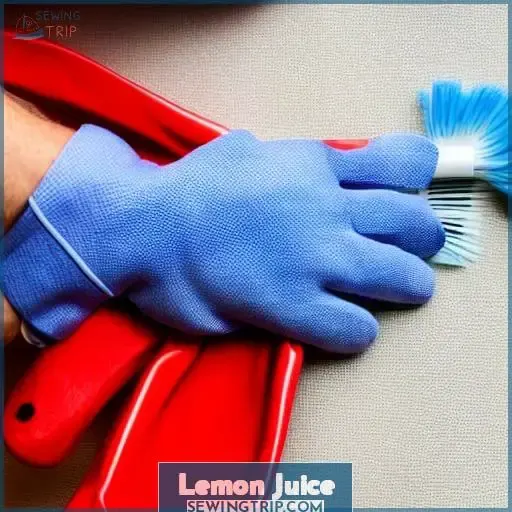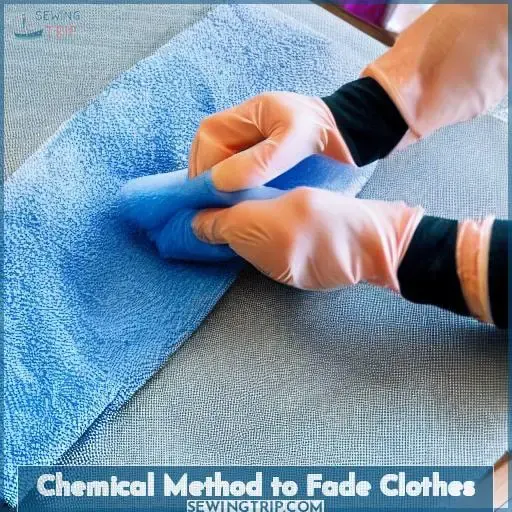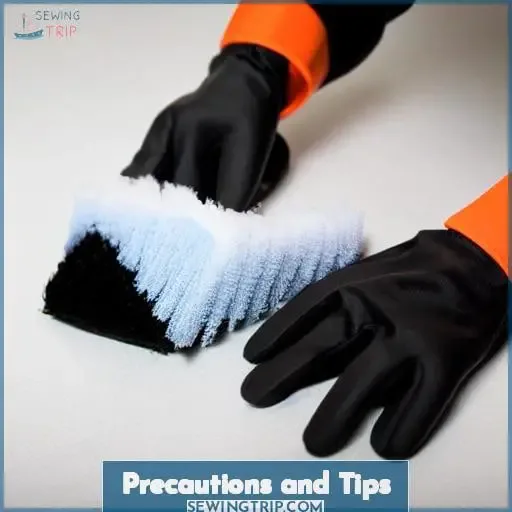This site is supported by our readers. We may earn a commission, at no cost to you, if you purchase through links.
Welcome to the wonderful world of fabric fading! It doesn’t have to be daunting. With just a few tips and tricks, you can easily get the faded look you want with minimal effort. If you want to give an old garment new life or create vintage-style clothing, fading fabric at home is a breeze. So, if you’re ready for some fun DIY projects that’ll save money and add creative flair, keep reading. We’ll explore how to fade fabrics like a pro!
Table Of Contents
What is Fading and How Does It Affect Your Clothes?
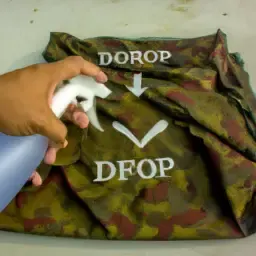
Whether you’re creating a vintage look or just trying to make your clothes last longer, understanding the effects of fading can help you preserve and customize your wardrobe. Fading’s caused by repeated washing with hot water, heavy settings on the washing machine and using bleach solutions in a manner that exceeds manufacturer’s instructions. Using mild detergents and fabric softeners will also reduce color runs from occurring during wash cycles, as well as setting iron temps correctly for specific types of material.
Bleaching damage can occur if bleach concentrations are too high, so it’s important to follow all manufacturer’s instructions when mixing up a bleach solution before soaking clothing items in them for an extended period of time. It’s best practice to always pre-cut fabric pieces before submerging them into any type of bleaching solution; this process ensures even fading across each piece without damaging any fibers inside the fabric itself, while maintaining its original shape throughout the entire procedure.
Sun Fade
You can easily achieve a vintage look with sun fading. It’s known to extend the life of clothes by years. Sunlight can fade most garments using natural UV-rays, even dark colored clothing like black jeans.
To use this method for fading fabric, you’ll need direct sunlight and a mixture of cold water and chlorine bleach, 1:10 ratio, in a spray bottle or container. Different methods include color mixing and techniques like distressing the material to get desired results. But it’s important to monitor how much time each article spends in direct sunlight, to prevent uneven color changes or over-fading due to prolonged exposure.
Lemon juice may also be used if certain fabrics are lightened too quickly from sun exposure. Mix 1 part lemon juice with 3 parts cold water, then soak the garment for at least 12 hours before washing off residue after drying out completely under shade away from bright lights.
With these simple steps you’ll soon have that perfect distressed look!
Washing Machine With Hot Water
You can achieve a vintage-style look with your garments by washing them in the machine on a hot cycle. Put on an apron and rubber gloves for protection. Use laundry detergent specifically designed for bright colours to reduce colour run from synthetic materials. Choose the hottest water setting and add fabric softener if necessary, but be careful not to overuse it as too much could cause fading or discolouration. For more intense fading effects, use a bleaching bath – fill a bathtub with one part bleach and ten parts hot water, and add the garment. Make sure all pieces are submerged – pre-cut them into sections if needed – then set a timer according to desired shade intensity (15 minutes should do). Rinse thoroughly under cold running water and wash off any residue with soap. Air dry outside or inside out in the dryer at a low heat setting until fully dry, then iron.
Baking Soda and Salt
Adding baking soda and salt to the water in your washing machine can help ‘spice up’ the texture of your fabric, giving it a unique vintage feel. If you want to experiment with lightening or fading colors without using bleach, adding baking soda and salt is an excellent option for fabrics that are not particularly delicate.
Before beginning, make sure you have all necessary safety equipment such as rubber gloves and aprons. Start by mixing one part baking soda with two parts hot water until dissolved completely. Then add four cups of iodized salt into a gallon-sized bucket filled with cold water along with this solution.
Submerge the fabric pieces one piece at a time in this mixture for several hours. This will allow heat transfer from within the bleaching solution which helps darken colors like black jeans or shirts. It also provides sun protection when outside drying is necessary afterward due to lack of indoor space available for air drying clothes properly over long periods if needed.
This method works well on heavier fabrics but should be used cautiously on more sensitive materials. Bleaching solutions may damage fragile fibers over time, so take care when executing DIY projects involving color remover techniques!
Vinegar
To create a unique, vintage-style look to your fabric, try using vinegar! It’s all-natural and contains acetic acid, which helps break down natural dyes and color pigments while preserving the overall material. Wear rubber gloves when handling clothing soaked with it. Soak for several hours (or overnight), then rinse and air dry or iron on low heat. As with any chemical process involving bleach alternatives, do it in a well-ventilated area away from direct sunlight or flame sources. This natural method allows you to control how much dye is removed and create beautiful color blends without damaging delicate fibers.
Lemon Juice
To give your fabric a vintage look, try adding some lemon juice to the mix – it’s an easy and natural way to create a special hue with no harsh bleaching agents necessary.
Mix one part of fresh-squeezed lemon juice with three parts of water and soak the garment in this solution for at least 12 hours. Wear protective rubber gloves while handling any kind of bleach or chemical solutions.
Rinse it out thoroughly under cold running water before proceeding with a cold wash cycle on your washing machine. Add salt or vinegar into each cycle and air dry instead of drying by machine whenever possible. Sun fading can be used when weather permits, but should be done cautiously and monitored to ensure all parts are evenly faded over time.
Lemon Juice is also effective for stain removing and color blending without risk damaging fibers like chlorine bleach would; however results may vary from fabric type to fabric type, so test first before attempting large batches!
Chemical Method to Fade Clothes
Take your clothes to the next level with a chemical method of fading; choose from options like bleach or vinegar and tea for an elevated, vintage look. Wear rubber gloves when handling any type of peroxide solution – it can be harsh on skin and cause irritation if not used properly.
If you’re looking for fast results, bleaching agents are the way to go. Color runs can happen suddenly when using chemicals, so spot-fading may need to be done to achieve uniform results over large areas quickly.
Hydrogen peroxide is often used by professionals but shouldn’t exceed two parts hydrogen peroxide mixed into ten parts hot water – it can start eating away at fibers in the cloth material, causing irreversible damage that can’t be undone.
After soaking your garments in this mixture, rinse them off with cold water, wring out excess liquid, and iron dry – making sure each piece has dried evenly across its entirety before sewing together again into something new.
With these easy steps and following safety precautions, you’ll find yourself easily achieving professional quality faded looks without ever leaving home!
Precautions and Tips
When fading fabric at home, it’s important to take the right precautions and follow some tips for a successful DIY project! Before you begin, make sure you have all the necessary materials such as rubber gloves, aprons and safety goggles.
Test whether your fabric is dye-fast or not by using a bleach solution before attempting any full scale fading process. Never use more than 2 parts of bleach per 10 parts of water; otherwise this can cause damage to fabrics fibers, weakening and eventually tearing them apart over time.
To ensure even color subsumation when using natural dyes like lemon juice or vinegar mixtures, don’t pre-cut your fabrics so they can sit nicely in the mixture bathtub for uniformity throughout the entire submersion period.
Add a cupful of baking soda into washing machine loads if using laundry detergent during the washing cycle, and fabric softener afterwards. These two ingredients help reduce color bleed out which could occur due to dry cleaning methods that require cold water only exposure instead of the warm/hot ones typically used during regular washes at home.
Frequently Asked Questions (FAQs)
What is the best way to fade a black t-shirt without turning it grey?
Fading a black t-shirt without turning it grey can seem impossible. But with the right knowledge and materials, you’ll create a vintage look in no time!
For natural solutions without bleaching products or distressing techniques, try air drying the shirt in direct sunlight. This will give it a subtle sun fade effect.
If you’re going for color blocking, grab some rubber gloves and mix one part bleach to ten parts hot water. Submerge the fabric in the mixture for 15 minutes, then rinse with cold water.
Finally, iron dry your garment.
Voila! Fading fabric has never been easier or more cost effective. So don those aprons and get ready to master this crafty skill!
Can I use chlorine bleach to fade bright clothes?
When it comes to fading bright clothes, chlorine bleach can be used but should be done so with caution. Commercial bleaching agents contain ammonia, so handle with safety in mind.
Bleach-free alternatives such as baking soda, salt, lemon juice and vinegar are also available for fabric fading.
Do a colour fastness test before beginning any project involving dyes or bleaches on clothing items. This’ll ensure fabrics remain dye-fast without bleeding colours during washing cycles or when exposed to sunlight.
For a safer option than commercial products, try using fabric safe dyes or pre-mixed solutions like those found in first bin kits. Don’t forget rubber gloves and protective gear for optimal results when fading clothes at home.
What is the best way to fade clothes without bleach?
Fading clothes without bleach can be tricky but rewarding. Wear rubber gloves and an apron. Use dye-stripping oxidative detergents or gentle washing solutions with natural oils to remove color. If that doesn’t work, try antimicrobial detergents for stronger results and protection against bacteria. Pre-cut fabric pieces to ensure even fading. Submerge in hot water mixed with 1 part bleach to 10 parts water. Do all items in one batch for uniformity. Rinse off the solution under cold running water after 15 minutes. Iron it dry. Take safety precautions when working with chemicals like chlorine bleach. Cut material beforehand for even coverage. Sit back and watch beautiful vintage colours appear. Fading fabric at home is cost effective and satisfying.
How do I avoid uneven fading when fading fabric at home?
Fading fabric at home can be cost-effective. Pre-cutting your fabric and using bleach with caution will ensure it fades evenly without damaging the fibers. Have rubber gloves and an apron on hand for protection, as well as measuring cups for blending solutions properly. To avoid uneven fading, consider pre-fading in soda soak or salt baths before submerging in diluted bleach solutions (1 part bleach: 10 parts water). Neutralize any chlorine odor by rinsing with cold running water with chlorine neutralizer after draining off the bleach solution. Air dry and iron when completely dry, then sew items such as pillow shams of desired shade. With these steps you’ll be able to masterfully fade fabrics like a pro!
What is the safest way to fade fabric using bleach?
If you’re looking to make a dramatic change in the color of your fabric, using bleach is one of the quickest and most effective ways. However, it’s important to take safety precautions when bleaching fabrics at home. Wear rubber gloves and an apron while handling bleach, and protect any surfaces that come in contact with it.
Mix up your solution using 1 part bleach to 10 parts hot water. Use measuring cups for accuracy; too much or too little can result in uneven fading or damage the fibers of your fabric.
If time allows, consider natural alternatives like lemon juice and vinegar. These will also produce good results without having such a negative environmental impact than chlorine-based products do.
Conclusion
Fading clothes at home can create a vintage, customized look. You can easily create a one-of-a-kind look with the right materials and know-how. As the old saying goes, “practice makes perfect”, so experiment with different fading techniques until you find the one that works best. With patience and practice, you’ll be able to create the perfect look. Just remember to be cautious with the bleach and to follow safety precautions.

